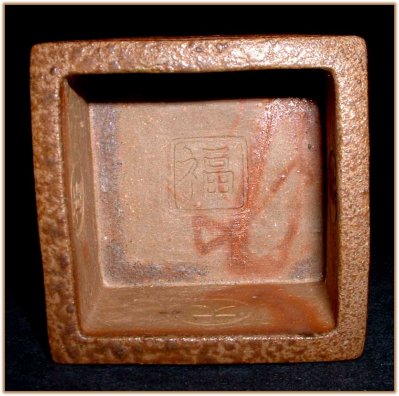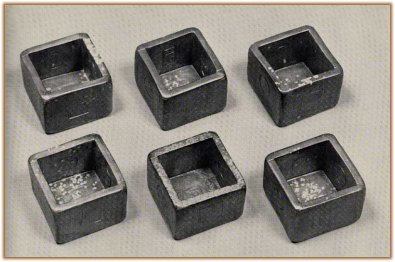|


The Four Winds
& Shimamura Hikaru
Story by Robert Yellin
First Published Honoho Geijutsu #67, Aug. 2001

The four winds have been part of legends from ancient Greece to the Native North American Indians. From each of the four cardinal directions, humans have been granted nature's blessings of rain, wind, sunshine, and light. In a sense, giving us fuku - the Japanese word for happiness and luck. The kanji for "fuku" is seen here inside this four-sided, four-winds masu (or sake nomi, meaning sake cup).

Actually, it's a bit different to drink from this rather traditional shaped Bizen masu. Masu, of course, are common wooden drinking vessels, but they are almost unheard of for Bizen. First, one has to pucker up the lips as if to whistle, place the mouth over one corner, and then slightly relax the upper lip a bit to let the sake flow into the mouth. It's almost impossible to drink from the sides, as the sake would just dribble onto your shirt. No way around it, this is a corner cup - a clay masu made by Shimamura Hikaru.
I first saw such a cup some years ago. It was a picture of a set of six masu chinmi-ire (small delicacy plates) made by Kaneshige Toyo around 1937 or 1938. Being the creative lot that we sake drinkers are, after the tasty tidbits had been all eaten, some chap "full of fuku" decided to pour a little sake in the chinmi ire I imagine. Of course, the masu shape invites one to drink with its historical references anyway. But how fun to change from the round to the square every now and then. In sake drinking too there should always be a bit of asobi kokoro (playful spirit).

These days not many Bizen potters have that asobi kokoro. Contemporary Bizen seems to be such serious stuff. Yet, Shimamura is following in the saiku (detailed carved works) tradition, and his output is much like the early works of Kaneshige Toyo. After Kaneshige, Isezaki Yozan, Koyama Isso, and Nishimura Shunko (among others), Shimamura is the best in his playful designs, fine skill and wit. He also makes a fine Bizen masu sake nomi, ala Kaneshige.
I was so happy to get this sake nomi one day in Tokyo that I couldn't even wait to get back home to fill it up. Off to a recommended Tokyo izakaya I went, and ordered some junmai right away. They brought a wasabi green plate over on which sat a standard ichi-go glass running over a bit with the drink of the gods. I took Shimamura's masu and poured the sake from the glass into it and sat it down on the green plate again. The staff stared. What a match! The deep bronze tones on the piece contrasted with the wasabi toned plate and the excess sake on the plate rose up in the base of the masu giving it a shimmering effect. It's best that this masu is a tsuchi-aji piece (clay-flavored piece) flecked with goma (sesame-colored glaze); I don't think it would look good with any other kind of Bizen keshiki.
Inside, wisps of hidasuki (scarlet red fire chord markings) are frozen in time to the right of the fuku kanji.
And the four winds blow on, cooling our brows in the heat of summer, bringing falling leaves in fall, snow in winter, and seeds in spring -- such is the fuku blessings in that. In silent praise, I raise this masu, thank each wind, pucker my lips, and take a big gulp at the corner.

Six Chinmi Ire (delicacy vessels)
Pottery of Kaneshige Toyo
Photo courtesy Kaneshige Toyo Exhibition Catalog
Published 1977 by Mainichi Shimbun
LEARN MORE ABOUT THIS ARTIST
Japan Times Story Dec. 9, 2000
SMALL BUT NOT SLIGHT
The tiny treasures of Shimamura Hikaru
|